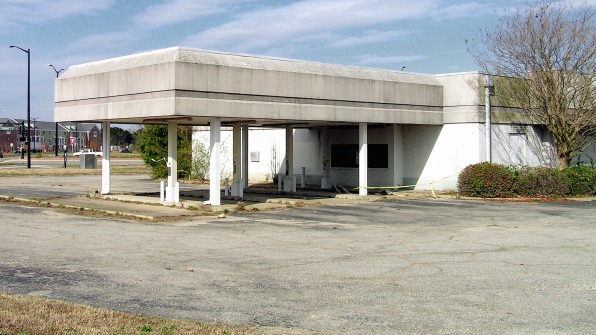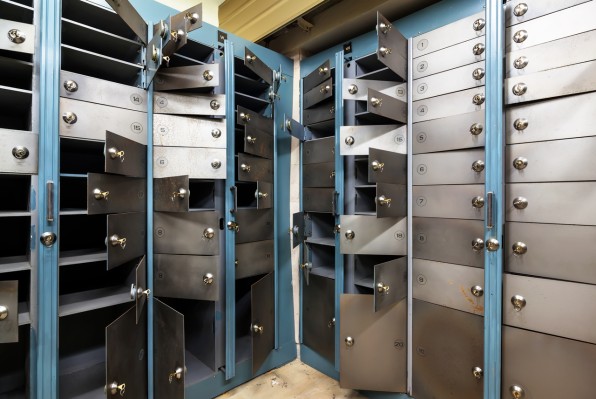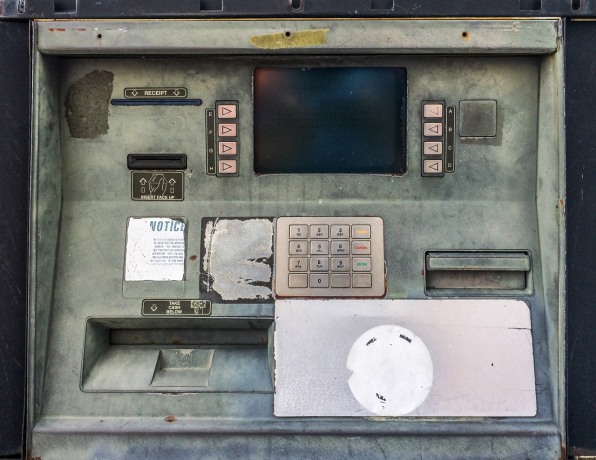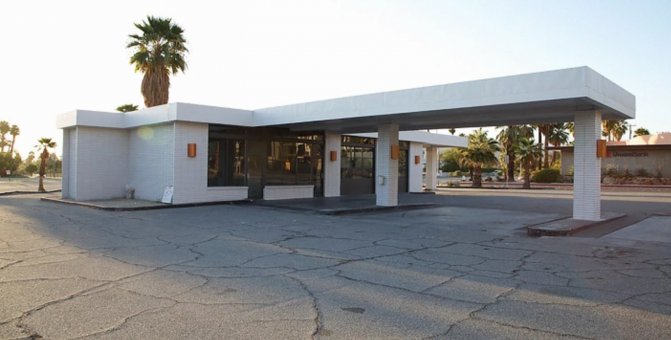Apart from the familial ties that I was born into, my relationship with Wells Fargo may have been one of the longest-standing of my life. Since I was 11 years old, I’ve had a savings account with the bank, linked to my parents’ finances. I don’t remember how old I was when I opened my first checking account, but I assume I was in high school. When I moved to New York three years ago, I set up my first credit card in a Wells Fargo branch office and felt very adult and also concerned about the streak of fiscal irresponsibility the new plastic might unleash in me. What company I banked with felt as inevitable as the family I was born into and the state in which I grew up. Putting my Wells card down on the table at dinner, I often felt a bizarre affection for how it identified me as a Californian.
But despite that sentimentality, Wells and I have parted ways. The decision was mine, and the idea to make it began to percolate earlier this year, as allegations of the bank’s financial investment in the Dakota Access Pipelinebegan to come out. That California-based sentimentality over my account had morphed into something more resembling nausea, knowing my money was funding something I didn’t believe in. But even so, it’s taken me until now (longer than it took the entire city of Seattle) to make a switch.
After I decided I wanted to pull my money from Wells, I had to confront the fact that I had no idea what I was doing. How would I go about finding a new bank I could trust? When should I move my money, and how? It took a series of conversations and months of thought and preparation, but I’m sharing what I learned here to make it clear that it’s not as overwhelming as it seems.

DO YOU BELIEVE IN YOUR BANK?
Where you bank is not fated; it’s a personal choice. Or rather, it should be, but the same forces of apathy, ignorance, trepidation, and laziness that were preventing me from taking my finances out of an institution with which I ethically disagreed prevent too many others from doing the same. When you’ve frequented the same ATMs and logged into the same online bank account for the majority of your life, a move away from that institution can feel rather like stepping off the edge of a cliff.
But it’s a cliff that’s proving increasingly intriguing for many young Americans, who have been losing faith in our large financial institutions. Wells Fargo is not alone in finding itself at the center of a scandal: In 2015, Citibank was ordered to pay back its customers a total of $700 million for misleading credit card marketing; Jamie Dimon, the CEO of JPMorgan Chase, is still at the helm of the company despite knowing of and ignoring to Bernie Madoff’s $64 billion Ponzi scheme, largely run through JPMorgan Chase account and considered the most fraudulent financial scheme of all time. Both institutions, along with Bank of America and Wells Fargo, were the engines that both created and punctured the housing bubble that precipitated the financial crisis of 2008. As Robert Jackson Jr., a law professor at Columbia University, told Quartz, “there’s no such thing as a ‘good’ big bank after the financial crisis.”
“Generally and broadly, there’s a lack of trust among millennials in the financial industry, and it’s deserved,” Ariel Anderson, a financial planner at Society of Grownups, a personal finance organization aimed at young people, tells Fast Company. “We constantly read headlines about the missteps of banks like Wells Fargo; we lived through the financial crisis,” she says. And large financial institutions are representative of the capitalist system, which, as Fast Company has reported, has fallen out of favor with more than 51% of the millennial demographic.
Various organizations have tapped into this trend: In 2011, during the height of the Occupy Wall Street movement, a group of organizers designated November 5th as Bank Transfer Day, and encouraged consumers to move their money into nonprofit credit unions or ethical financial institutions. This past year, Green America suggested that people funnel their Valentine’s Day discomfort into a breakup with their big bank. (Though there are no estimates as to how many people participated, Bank Transfer Day drew around 50,000 members to their Facebook page). Both organizations emphasized, however, that starting the process should not be confined to these designated days: You should begin to move your money whenever you feel ready and able to do so.
So that being said, here’s what I’ve learned from making the switch out of a big bank:

DO YOUR RESEARCH
Given that I parted ways will Wells Fargo over an ethical quandary, I wanted to find a new platform that wouldn’t compromise my values. Community Development Financial Institution (CDFI) banks and credit unions, generally, target their investments more toward local investments and causes, rather than destructive projects like DAPL. Credit unions are highly localized, member-owned nonprofits that provide financial services to the communities in which they operate; CDFIs are private, for-profit institutions that make loans to underserved communities (read more about them here). The Harbor Bank of Maryland, for instance, recently made a loan to East Baltimore Development Inc. that has gone toward financing new science buildings for local schools. The Opportunity Finance Network, an umbrella organization for CDFIs, has a helpful search tool to use to locate nearby community development banks.
Ethical banks like Aspiration in the U.S. and Triodos in Europe, both of which boast sustainable and fossil-fuel-free investment portfolios, are another alternative. Though less hyperlocal than CDFI banks and credit unions, ethical banks are driven by good–Aspiration, for instance, devotes 10% of its revenue to charity, and charges customers only what they feel is fair to pay–and aim for institution-wide transparency to counteract the labyrinthine structures of big banks.
For the sake of disclosure, after a long and thorough search process, I opened an Aspiration account. Spring Bank, a New York-based CDFI, was a close contender, but another thing to consider about banking with a CDFI is that you ought to be firmly settled in your community to do so–I still have strong ties to the West Coast as well as New York, so I wanted a bank that would offer me more flexibility in terms of location (Aspiration is all online). But give me a few more years to become a a rooted New Yorker, and experienced bank switcher, and I can see myself opening another account with Spring Bank. Both Aspiration and Spring represent another bonus of ethical banking: They reimburse all ATM fees.

MAKE SOME (VERY CAREFUL) MOVES
Once you’ve analyzed your options and selected a new account that aligns with your ethics, now’s the time for the tricky part: Actually moving your money. This is best done very slowly (the whole process took me about two months). I talked to Andrei Cherny, CEO of Aspiration, after I decided to open an account with them, for some tips; here’s what he recommended.
If you have more than one account open with your big bank–I had two checking accounts and a savings account–consolidate your money into one account, then alert your bank that you will be closing the others. I communicated with Wells Fargo through email, which was surprisingly simple, but you can also visit a physical branch and meet with a representative who will walk you through the process. Then, open your new account–I transferred just $500 to begin with, and most banks will suggest a minimum deposit–and if you’ve been receiving direct deposits from your employer, talk to your HR representative to get a new form to route your checks into your new account. I recommend doing so immediately after receiving a paycheck, so there will be enough time in between checks to link the new account. For me, it took less than two weeks.
While you’re waiting for your new card to arrive in the mail, go through last month’s bank statement from your old account to identify and cancel automatic payments and recurring transfers (some examples: the amount I regularly moved into my savings account with each paycheck; my Optimum bill; my monthly Netflix payment). Then, go through your payments systems, like Venmo and Apple Pay, and make sure those are linked to your new account or card, when it arrives.
When it does, you can do a big transfer from your old account to your new one. To do so, you’ll need to link your old account with your new one. On your new bank’s website, find the “bank transfer” section, select your old bank from a list (you’ll see all the big ones–Wells, Bank Of America, Citi, and so on), and sign in. You’ll then select whatever account you want to link, and how much money to move to your new bank.
It’s best to keep some money in your old account if you’ve missed any automatic payments–you don’t want to be hit with an overdraft fee while you’re trying to financially liberate yourself. And it’s also best to keep that old account open with a small amount of cash in it for a couple of months after migrating, just in case of emergencies.

WHILE YOU’RE AT IT, FACE DOWN YOUR FINANCES
I expected to feel good about putting my money into an account that I chose, and I do. But the unexpected benefit to this whole, long process, was the opportunity to get up close and personal with my finances. In addition to a distrust of large financial institutions, JJ Ackles, the director of marketing for Long Game, a prize-linked savings account app, tells Fast Company that young people tend to get trapped in an avoidance cycle when it comes to their money. “It’s like: I feel shitty about my money, therefore I don’t want to look at it, therefore I don’t look at it, therefore I feel shitty about it,” Ackles says.
When you move all your money to a new account, you have to look at it. And that opens the door to considering new ways to handle it. There are apps like Long Game, which reward every time you move money into your savings account with the opportunity to play addicting, lottery-like games and potentially win more money; other savings platforms like Digit help you set up specific savings goals.
And it’s also, says Erin Lowry, blogger and author of Broke Millennial, not a bad time to consider investing, if you haven’t done so already. Though the financial industry has a history of making investing into an opaque endeavor, available only to those with substantial monetary worth and knowledge, that’s actually not the case. New tools now exist that both lower the financial bar to investing, and make it easier to tailor your investments to support causes you care about. Aspiration, for instance, manages two funds with a $100 minimum investment, both of which support only companies with solid environmental and ethical commitments. The startup OpenInvest has a $3,000 minimum investment, but takes the unique approach of asking you what you care about, whether it be climate change or low-income housing development, and builds out a portfolio unique to you. (Fast Company has done a thorough roundup of what you need to know to invest to fit your values.)
Taking your money out of a bank with which you clash ethically frees you to use your money to have the kind of impact you want on your life and on the planet. “People are looking for better tools and better ways to manage their money,” Ackles says. “We want to create a way for people to have a positive interaction with their money.”
And taking that step, Lowry says, will begin to put pressure on the big banks to reconsider their own ethics. “We need to educate ourselves and we need to stop putting our money in institutions that we feel are unethical,” Lowry says. “So many people don’t even bother to do the diligence and just stick with the status quo. That makes it easier for the old banks who have not changed their policies to behave in the way they have always done, just because they can.”




